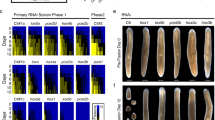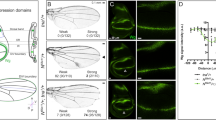Abstract
THE first instar larva of Drosophila consists of a chain of segments or parasegments1 in which the morphological pattern characteristic of each metaniere is determined by the homoeotic genes2–4, which are active in overlapping domains and are known to interact among themselves5–9. The interactions occur at the level of transcription and allow some homoeotic genes to control the patterns and levels of expression of others. The best known among them are the down-regulation of Antennapedia (Antp) by Ultrabithorax (Ubx) and that of Ubx by abdominal-A (abd-A) and Abdominal-B (Abd-B). It has been proposed7,10,11 that these cross-regulatory interactions play a part in specifying cell pattern, and hence the identity of each metaniere. Here we assess the functional significance of some of these interactions by expressing the Antp, Ubx or both homoeotic genes under the control of the heat-shock promoter12–14. Predictably, we find that homoeotic gene products evade normal regulatory controls and can be maximally expressed in regions where they are normally down-regulated, but, surprisingly, we find that interruption of the normal down-regulation of Antp and Ubx has no phenotypic consequences in the epidermis, where homoeotic phenotypes are normally manifest. Hence our results challenge the view that these, and possibly other cross-regulatory interactions have a role in determining segmentai identity.
This is a preview of subscription content, access via your institution
Access options
Subscribe to this journal
Receive 51 print issues and online access
$199.00 per year
only $3.90 per issue
Buy this article
- Purchase on Springer Link
- Instant access to full article PDF
Prices may be subject to local taxes which are calculated during checkout
Similar content being viewed by others
References
1. Martinez–Arias, A. & Lawrence, P. A. Nature 313, 639–642 (1985). 2. Lewis, E. B. Nature 276, 565–570 (1978). 3. SÃ nchez–Herrero, E., Vernos, l., Marco, R. & Morata, G. Nature 313, 108–113 (1985). 4. Wakimoto, B. & Kaufman, T. C. Devi Biol. 81, 51–64 (1981). 5. Struhl, G. Proc. nain. Acad. Sci. U.S.A. 79, 7380–7384 (1982). 6. Hafen, E., Levine, M. & Gehring, W. J. Nature 307, 287–289 (1984). 7. Struhl, G. & White, R. A. H. Cell 43, 507–519 (1985). 8. Bienz, M. & Tremml. G. Nature 333, 576–578 (1988). 9. Carroll, S. B., Laymon, R. A., McCutcheon, M. A., Riley, P. D. & Scott, M. P. Cell 47,113–122 (1986). 10. Beachy, P. A., Krasnow, M. A., Gavis, E. R. & Hogness, D. S. Celi 55, 1069–1081 (1988). 11. Peifer, M., Karch, F., Bender, W. Genes Dev. l, 891–898 (1987). 12. Schneuwly, S., Klemenz, R. & Gehring, W. J. Nature 325, 816–828 (1987). 13. Gibson, G. & Gehring, W. J. Development 102, 657–675 (1988). 14. Kuziora, M. A. & McGinnis, W. Cell 55, 477–485 (1988). 15. Struhl, G. Nature 308, 36–41 (1981). 16. Struhl, G. J. Embryo!, exp. Morph. 76, 297–331 (1983). 17. Mlodzik, M, Fjose, A. & Gehring, W. J. EMBO J. 2569–2578 (1988). 18. Mahaffey, J. W., Deiderich, R. J. & Kaufman, T. C. Development 105, 167–174 (1989). 19. Chadwick, R. & McGinnis, W. EMBO J. 6, 779–789 (1987). 20. Regulsky, M., McGinnis, N., Chadwick, R. & McGinnis, W. EMBO J. 6, 767–777 (1987). 21. LeMotte, P., Kuriowa, A., Fessier, L. I. & Gehring, W. EMBO J. 8, 219–227 (1989). 22. Krasnow, M. A., Saffman, E. E., Kornfeld, K. & Hogness, D. S. Cell 57, 1031–1043 (1989). 23. Wirz, J., Fessier, L. I. & Gehring, W. J. EMBO J. 5, 3327–3334 (1986). 24. Beachy, P. A., Helfand, S. L. & Hogness, D. S. Nature 313, 545–551 (1985). 25. Gehring, W. J. & Hiromi, Y. A. Rev. Genet. 20, 147–173 (1986). 26. Akam, M. Development 101, 1–22 (1987). 27. Muller, M. et al. EMBO J. 7, 4299–4304 (1988). 28. Struhl, G. Nature 338, 741–744 (1989).
Author information
Authors and Affiliations
Rights and permissions
About this article
Cite this article
Gonzalez-Reyes, A., Urquia, N., Gehring, W. et al. Are cross-regulatory interactions between homoeotic genes functionally significant?. Nature 344, 78–80 (1990). https://doi.org/10.1038/344078a0
Received:
Accepted:
Issue Date:
DOI: https://doi.org/10.1038/344078a0
This article is cited by
-
Chromatin accessibility plays a key role in selective targeting of Hox proteins
Genome Biology (2019)
-
Developmental competence and the induction of ectopic proboscises in Drosophila melanogaster
Development Genes and Evolution (2013)
-
Hox Genes and Their Candidate Downstream Targets in the Developing Central Nervous System
Cellular and Molecular Neurobiology (2005)
-
Ultrabithorax protein expression in breakpoint mutants: localization of single, co-operative and redundant cis regulatory elements
Roux's Archives of Developmental Biology (1994)
-
Regulatable endogenous production of cytokinins up to ?toxic? levels in transgenic plants and plant tissues
Plant Molecular Biology (1993)
Comments
By submitting a comment you agree to abide by our Terms and Community Guidelines. If you find something abusive or that does not comply with our terms or guidelines please flag it as inappropriate.



